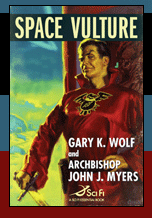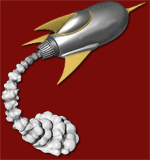|
After watching a few too many of those Saturday morning TV commercials in the 1970s, Gary K. Wolf came up with the idea for his novel “Who Censored Roger Rabbit?” which became the film “Who Framed Roger Rabbit.”
It also helped that Wolf had a background as an advertising copywriter and a longtime hobby of writing science fiction novels. Three of them had already been published before the idea for “Roger Rabbit” came to him.
“I started seeing the Trix rabbit, Cap’n Crunch, Snap Crackle and Pop, and Tony the Tiger, who are cartoon animals messing around with real kids, and nobody seemed to think that’s odd,” says Wolf, a longtime Brookline resident. “I thought, what an interesting premise — a world where cartoon characters were real.”
The enormous success of the resulting book, and of the movie, gave him the financial freedom to start writing full time. His newest book, written in collaboration with his boyhood friend John J. Myers, now the archbishop of Newark, NJ, is “Space Vulture,” an action-filled science fiction throwback to the pulp thrillers that Wolf and Myers devoured when they were teenagers.
“We both loved to read as boys,” says Wolf. “I read mostly adventure stories and John read biographies and history, but we both loved science. One day in the 7th or 8th grade he came to me with a book he found in the school library. It was called ‘Space Hawk,’ written by Anthony Gilmore. I read it and was enthralled by it. We both thought it was like a Western in space. So we started looking for more of this science fiction stuff. We started reading Bradbury and Heinlein, and we got hooked.”
Decades passed. Wolf and Myers remained close friends. About seven or eight years ago, Wolf located two copies of ‘Space Hawk’ so they could “kind of relive our youth,” recalls Wolf. “So we read it again, and it was the worst damn thing we’d ever read. It was awful, it was trite, it had a cardboard hero. John thought it was pretty bad, too. So one of us, I can’t remember who, said, ‘It’s really a shame that the two of us can’t write one that is ‘Space Hawk’ as we remembered it.’ That’s what got us going.”
But the resulting “Space Vulture” is kind of a revisionist “Space Hawk.” The old book featured Hawk Carse, the gallant hero. In the new one, besides lots of ray guns, there’s a hero named Corsaire, described as “the bravest, most righteous lawman in the galaxy,” and there’s Space Vulture, “the galaxy’s deadliest villain.”
“There’s also an anti-hero, Gil Terry,” says Wolf. “He’s sort of a rapscallion, a rambler and a gambler. He’s out for himself, but we do kind of root for him.”
To round things out, there’s Cali Russell — the tough, beautiful, single mom of 11-year-old Eliot and 7-year-old Regin — who runs an Outworld space colony and finds herself in a heap of trouble with the heinous Space Vulture and his “terrifying legion of bloodthirsty soldiers.”
With Wolf in Brookline and Myers in Newark, the book was completed over a five-year period. Wolf did most of the actual writing, and Myers contributed a lot of the character development and the structuring of personalities.
Both men wanted to send a couple of nods of recognition to the book that got them started on this project. “The one thing that both John and I remembered from ‘Space Hawk’ was that Hawk Carse pulled out his ray gun and put it back before anybody even realized he’d drawn it, and the only thing that remained was the sweet smell of scorched flesh in the air, and a small hole between the eyes of the guy he shot.”
Wolf laughs at that memory and at the fact that a similar scene is in “Space Vulture.” “We never forgot that,” he says. “That’s a direct homage.”
Wolf gives full credit to Myers for toning down his penchant for a more raw style of prose. No surprise there since he’s a man of the cloth. As an example, Wolf points to the character of Gil, who he refers to as “kind of the good-bad guy. He starts off as a villain and has an arc. That was John. The other thing John wanted, which I had no problem putting in because I thought it helped to define the character, is the fact that Cali was religious, and in times of trouble she prays, and so does one of her boys.
“This is not a walk through the Vatican rose garden,” adds Wolf. “This has got Space Vulture, and flesh-eating aliens and human slavery and ray guns. It’s no goody goody novel, but it is moral.”
Wolf believes that, aside from it being something he wishes he read as a kid, “Space Vulture” will please fans of traditional science fiction stories with a lot of action and will appeal to the “Star Trek” and “Star Wars” crowds.
And he’s hoping it will be adapted to film.
“It was the only book that our agent was showing during the writers strike,” he says, “and right now two or three different producers have got it and are reading it. We’re going for it!”
“Space Vulture” was released on March 4 on Tor Books.
--Ed Symkus, GateHouse News Service



